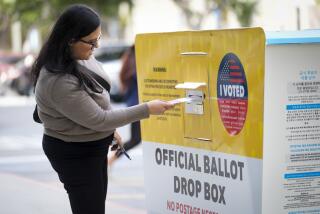Parks Package Has Something for Everyone
- Share via
On the surface, the $319-million parks measure on the Los Angeles County ballot is very simple. Underneath lies a story of intense behind-the-scenes bargaining at the Board of Supervisors.
For Measure A was carefully crafted to draw maximum support by offering something for almost everyone from young people in danger of joining gangs to seniors needing a safe place to meet.
The ballot measure would raise property taxes modestly--an estimated $6.76 a year for the average homeowner--to pay for an ambitious program to expand parks, buy open space, upgrade recreational facilities, improve beaches, renovate museums and restore cultural attractions.
If the voters approve, all 88 cities in the county would get a piece of the action. Money would be raised to create inner-city parks and riverfront bike trails, preserve scenic mountain and desert lands, protect wildlife habitat and save open space from development.
And it would expand the power and influence of one of the region’s most important park agencies: the Santa Monica Mountains Conservancy.
Measure A would extend the conservancy’s reach well beyond the Santa Monica and Santa Susana Mountains to encompass park development along the entire Los Angeles River and its tributaries. And it would give the hard-pressed conservancy, a state agency that buys land threatened with development, a presence across the county as far east as the Whittier-Puente Hills.
“Los Angeles County and its communities are among the most park-poor in urban America,” said Esther Feldman, a former conservancy official and the architect of this measure and two county park measures before it.
Feldman said entire areas of the nation’s most populous county lack parks, open space and recreational amenities. Measure A is designed to change that. “It is extremely vital to the quality of life,” she said.
The $1.1-million campaign to win passage on Tuesday is being underwritten by environmental groups and major cultural institutions, which would be among its chief beneficiaries.
The effort headed by Feldman has taken on new urgency because of fears that a statewide ballot measure to tighten restrictions imposed by Proposition 13 could impose a tougher two-thirds requirement for passage of future park measures.
The opposition to Measure A comes from the Howard Jarvis Taxpayers Assn., which objects to raising property taxes for the next 22 years to foot the bill.
Joel Fox, the group’s president, questioned the wisdom of increasing a park tax while the county faces severe problems in other high-priority areas. “The supervisors were able to put a park tax on the ballot at a time when they couldn’t open the Twin Towers jail,” he noted.
Fox said county voters already agreed in November 1992 to pay higher assessments to finance a $540-million parks program that was also known as Measure A.
Four years later, 24% of the money from that mega-parks measure--almost $130 million--has not been spent because city, county or nonprofit agencies have not sought the funds.
But some of the money raised by the original Measure A has paid for improvements to beaches along the Malibu coast and community swimming pools in the flatlands of the Los Angeles Basin. Funds have been spent to preserve quiet canyons in the Santa Monica Mountains as open space and build a nature center on Santa Catalina Island.
The latest Measure A, though smaller, is in many ways the twin of the 1992 proposition, with an emphasis on upgrading facilities for senior citizens and building parks and recreational facilities for young people at risk of joining gangs.
To that, add money to upgrade landmarks such as the Hollywood Bowl, the Los Angeles Zoo, the Museum of Science and Industry and the Natural History Museum. Then, give every city in the county a grant and offer nonprofit organizations a chance to compete for funds.
And when Supervisor Mike Antonovich complains that there aren’t enough projects in his district, simply make the measure bigger. In addition, reserve 15% of the funds to operate and maintain the park facilities.
After all the negotiating was done last summer, four of the supervisors had in the finest tradition of power politics put on the ballot a package of 140 specific projects from soccer fields to hiking trails, basketball courts to wildlife corridors.
Only Supervisor Gloria Molina expressed reservations about asking for another tax increase when the county faces more pressing needs. Lining up to support Measure A was a broad-based coalition of law enforcement and local officials, environmental, senior citizen and community groups.
That coalition was built in large part by Feldman. Her role began six years ago when she was a special projects director for the Mountains Recreation and Conservation Authority, an arm of the conservancy.
Feldman was instrumental in designing the biggest parks measure in the county’s history, an $817-million extravaganza in 1990. She left her job to run the campaign. Although it received 57% of the vote, the measure failed because it needed a two-thirds majority for approval.
Two years later, after state law was changed to require only a simple majority in certain cases, Feldman was again at the conservancy’s sister agency, putting together a $540-million county parks measure for the 1992 ballot. It won approval with 64% of the vote. The county issues bonds to provide up-front funds for park projects. Property tax assessments are used to repay the bonds.
Maintaining close ties to the conservancy, Feldman opened a Los Angeles field office of the Trust for Public Land, an organization that buys environmentally significant properties and sells them to public agencies.
After packaging the latest park measure, Feldman is again at the helm of the Yes on A campaign.
To pay for this effort, the Los Angeles Philharmonic donated $300,000, the Greater Los Angeles Zoo Assn. gave $250,000, the Sierra Club and the Trust for Public Land each kicked in $150,000, the Los Angeles County Museum of Natural History Foundation provided $85,000, and $25,000 checks came from USC, the California Museum Foundation and Supervisor Zev Yaroslavsky’s campaign fund.
The Santa Monica Mountains Conservancy would be the recipient of a healthy share of the park funds.
Measure A reserves $22.75 million for the conservancy to acquire mountain and canyon lands, streams, trails and scenic areas, and to develop senior citizen facilities and camps for at-risk youth in the Santa Monica Mountains, and the San Fernando Valley and San Gabriel Valley foothills. An additional $4 million would be available to acquire land in the vicinity of Stoney Point in the San Fernando Valley, plus $500,000 for the Rim of the Valley Trail.
The supervisors would have the ability to reject any project that could threaten the county sanitation agency’s access to mountain canyons for use as future landfills. And the conservancy, which had been locked in a long and bitter fight with Soka University, could not use the park money to buy land from unwilling sellers.
The conservancy’s Mountains Restoration and Conservation Authority would get $12 million to acquire land and make improvements along the Los Angeles River and its tributaries, including trails for hiking, biking, walking and equestrian use.
Joe Edmiston, the executive director of the conservancy and its sister agency, said the supervisors turned to the conservancy for help because it had a track record of developing public access to a stretch of the river upstream.
At least $2.5 million would be set aside to acquire land and build a new camp for at-risk youth in the Whittier-Puente Hills. The conservancy operates such a camp in the Santa Monica Mountains to give inner-city youth an introduction to nature.
(BEGIN TEXT OF INFOBOX / INFOGRAPHIC)
Measure A
Los Angeles County voters are being asked to raise property taxes to pay for a $319-million program to improve existing parks and cultural facilities, provide funds to buy more parkland and open space and fund anti-gang efforts and senior citizen centers. Additional funds would be provided to maintain park facilities. The average homeowner would pay $6.76 a year for 22 years, according to the measure’s backers.
A partial list of projects is presented below:
Cultural Facilities:
-- Hollywood Bowl: $18 million
-- Los Angeles Zoo: $12 million
-- Exposition Park, including California Museum of Science and Industry and California Afro-American Museum: $12 million
-- Los Angeles County Natural History Museum: $5 million.
-- Cabrillo Marine Aquarium, San Pedro: $2.8 million .
-- John Anson Ford Theatre: $1.5 million.
Acquiring Open Space:
-- Santa Monica Mountains: $17.75 million.
-- Los Angeles River and its tributaries: $12 million
-- Baldwin Hills park expansion: $11 million
-- Puente Hills wildlife corridor: $10 million
-- Santa Clarita Woodlands/Rim of the Valley Trail: $5 million
-- San Fernando Valley/Stoney Point Park expansion: $4 million
-- Rancho Palos Verdes/Portuguese Bend area: $4 million.
-- Whittier Hills/open space acquisition: $2.5 million.
-- Rolling Hills Estates/natural lands: $1 million
Bay and Beaches:
-- County beach improvements: $8 million
-- Reduce urban runoff to Santa Monica Bay: $4 million
-- Santa Monica: Enhance beach access and coastal parks: $1.7 million
-- Ballona Lagoon Preserve: $1 million
-- Malibu/Restore pier: $700,000
-- Hermosa Beach/Develop, expand, rehabilitate pier and waterfront plaza: $1 million.
Park Projects
Funding for $131.5 million in park projects, including $35 million in grants for every city and unincorporated areas of the county.
Antelope Valley
Palmdale/Anaverde Basin Sports Complex: $2.5 million
Lancaster/Prime Desert Preserve: $1 million
San Fernando Valleys and Northern Valleys
Agoura Hills/Calabasas: Regional Community Center: $1 million
Sepulevda Basin Recreation Area: $2.8 million
Burbank/Stough Canyon Nature Center: $800,000
Santa Clarita/Regional Park: $2 million
Castiac Lake: $1.7 million
Newhall/Hart Regional Park: $1 million
Vasquez Rocks County Park: $1.2 million
Sylmar/El Cariso Regional Park: $1.7 million
Hansen Dam Lake: $1.8 million
Glendale/Adult Recreation Center: $1.6 million
Metropolitan Los Angeles
West Hollywood/Plummer Park: $1.1 million
Elysian Park: $1.9 million
MacArthur Park: $1.5 million
City Terrace: $2 million
Franklin D. Roosevelt Park: $1 million
Develop L.A. Inner-City Parks: $5 million
Housing Authority Recreation Areas: $2.3 million
Compton-Slauson Regional Park: $2 million
Jesse Owens Regional Park: $1.7 million
Inglewood/Centinela Park: $1.7 million
Cudahy-South Gate: L.A. River Sports Park: $4.2 million.
San Gabriel Valley
Altadena/Loma Alta County Park: $1.2 million
Pasadena/Hanamonga Watershed Park: $1 million
San Gabriel/Smith Park: $1.7 million
Rosemead/Garvey Park Recreation Center: $1 million
Monterey Park/Barnes Park: $1 million
Duarte/Pamela Park Pool: $1.5 million
Whittier Narrows: $3.3 million
Whittier/Gunn Avenue County Park: $2.3 million
Pico Rivera/Community Center: $1 million
La Mirada/County Park: $1.3 million
Southeast and South Bay Area
Cerritos Park: $1.4 million
Long Beach: Westside Park, $3.9 million; Downtown, $3.5 million; Belmont Plaza Pool, $2 million
Torrance/Wilson Park Sports Complex: $1 million
East County
Claremont/Community Center: $1.2 million
El Monte/Civic Center Park: $1.5 million
San Dimas/Bonelli Regional Park: $1.2 million
Seniors:
Culver City Senior Center: $1.6 million
Central Area: $2 million
East Los Angeles and San Gabriel Valley: $1.6 million
Youth and Anti-Gang Efforts:
Los Angeles/For parks in densely-populated, highly urbanized areas with with high population of at-risk youth: $7 million
South Los Angeles/For parks serving youth or at-risk youth in the densely populated, highly urbanized areas in the central Part of the county, including Watts, Willowbrook, Florence and Athens: $2 million.
East Los Angeles and San Gabriel Valley: $1.6 million
Whittier/Puente Hills: Acquire and develop at-risk youth camp: $2.5 million.
Gardens:
Los Angeles Arboretum: $1.4 million
South Coast Botanical Gardens: $1.3 million
Historic Sites:
Pio Pico State Historic Park/Whittier: $2.5 million
Grants:
$14 million in competitive grants to public agencies or non-profit groups for trails, senior citizen facilities, urban tree planting, graffiti prevention, rivers and streams, and acquisition or restoration of natural lands.
Source: Text of Measure A
More to Read
Sign up for Essential California
The most important California stories and recommendations in your inbox every morning.
You may occasionally receive promotional content from the Los Angeles Times.










